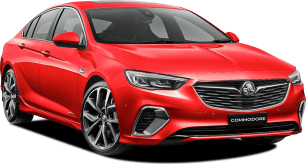Aligning with the Insignia’s European platform has bumped the Commodore right up to speed with the current status quo of features expected in such a family car.
Available Commodore firsts include standard auto emergency braking (AEB) on all models, adaptive cruise control, 360-degree / surround-view cameras, massage and ventilated seats, heated rear seats, wireless phone charging, LED headlights and a power tailgate on the wagons. Like most new cars, there’s no more CD player or DVD player with the radio and other multimedia options.
The broad model range is split into LT, RS, RS-V, Calais, Calais-V, VXR trim levels, while the off-road flavoured Tourer is split into Calais and Calais-V versions.
All bar the Tourer and VXR are available with either Liftback or Sportwagon ($2200 extra) bodystyles, while the 2.0-litre turbo engine is standard in the LT, RS and Calais. The V6 with all-wheel drive is available in the RS, RS-V, Calais-V, VXR and both Tourer trims, while the diesel engine is limited to the LT and Calais.
The base LT Liftback drops the Commodore entry point by $1800 with a list price of $33,690. The diesel engine is available in either bodystyle for an extra $3000.
Standard features include the aforementioned AEB, lane keep assist, lane departure warning, Apple CarPlay and Android Auto in addition to Bluetooth connectivity with a 7.0-inch multimedia screen, reversing camera, auto parking, a leather steering wheel, an eight-way power driver’s seat, proximity keys, auto headlights and wipers, air conditioning and 17-inch alloy rims.
The RS kicks off at $37,290, or $40,790 in V6 AWD guise, and brings sports front seats, steering wheel and body kit, blind-spot monitoring, rear cross-traffic alert and bigger 18-inch alloys, while the Sportwagon version gets a power tailgate.
The V6 AWD RS-V commands $46,990, and adds leather seats, heated front seats, paddle shifters a larger 8.0-inch multimedia screen with built-in GPS navigation system and DAB+ digital radio, a colour head-up display, wireless phone charger, interior ambient lighting, upgraded Hi Per strut suspension and a sportier rear bumper.
The $40,990 Calais is also available with the diesel engine for an extra $3000, or as the V6 AWD Tourer wagon for $45,990.
The Calais sits closer to the LT on features, but adds leather trim, front seat heaters, 8-inch multimedia screen with built-in GPS navigation system and DAB+ digital radio, wireless phone charging, blind-spot monitoring, rear cross-traffic alert and 18-inch alloys.
The Calais Tourer scores a ride height lift (overall height up 42mm) and off-road styled unpainted wheel-arch moulds and bumper caps.
The $51,990 Calais-V adds a Bose premium sound system, ventilated front seats, a massage function and powered side bolsters for the driver’s seat, heated rear seats, a sports steering wheel with paddle shifters, 360 degree cameras, colour head-up display, adaptive LED headlights and 20-inch alloys. The Liftback version gets an electronic sunroof, while the Tourer version gets a panoramic glass roof.
The top-spec VXR is closest to the RS-V in terms of features, but for $55,990 it adds VXR-specific sports seats with power adjustable bolsters and ventilation up front, heated rear seats, Bose premium audio, adaptive suspension, adaptive cruise control, Brembo brakes, VXR floor mats and sill plates, active LED headlights, 360-degree camera, electric sunroof, and 20-inch alloy wheels.
From launch, Holden is offering drive-away pricing across several models, with on-road costs included. The LT petrol Liftback is available for $35,990, while the RS Liftaback is being offered for $38,990 with the 2.0-litre turbo and $42,490 with the V6. The Calais Tourer is also being offered for $47,990 drive away.
MORE: Check out our ZB Holden Commodore price guide and price list here.
The available colours are spread across two whites, two reds, silver, grey, black and blue, with some only available on certain models. All bar the non-metallic white and red will cost you an extra $550, but there’s no sign of the green, purple, orange, or yellow we’ve seen over the past decade.






